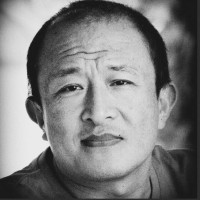If you want to know about buddhanature, then Maitreya’s Uttaratantra Shastra is the text you have to study. It’s important to be careful when establishing the idea of buddhanature, because otherwise it might end up becoming something like an atman, or a truly existing soul. The Mahayana shastras talk about the qualities of freedom, or elimination, such as the ten powers, the four fearlessnesses, the thirty-two major marks, the eighty minor marks, and so on. If you’re not careful, you might start to think about buddhanature theistically — that is, in terms of the qualities of a permanent god, soul, or essence. But all these qualities talked about in the Mahayana shastras are simply qualities of the absence of dirt.
When we talk about the result of elimination, we automatically think we are talking about something that comes afterward: first there is elimination and then comes its effect. But we are not talking about that at all, because then we would be falling into an eternalist or theistic extreme. “Elimination” means having something to eliminate. But in the Prajnaparamita, we understand that there is nothing to eliminate. And that is the big elimination. The result of that elimination isn’t obtained later. It’s always there, which is why it’s called tantra, or “continuum.” This quality continues throughout the ground, path, and result. The window continues from before the dirt was there, while the dirt is being washed away, and after the cleaning is complete. The window has always been free from the concepts of dirt and freedom from dirt. That’s why the Mahayana sutras say the result is beyond aspiration. You cannot wish or pray for the result of elimination, because it’s already there; it continues all the time, so there’s no need to aspire to it.

Dzongsar Khyentse Rinpoche
source: https://www.lionsroar.com/the-clarity-aspect/
Read a random quote or see all quotes by Dzongsar Khyentse Rinpoche.